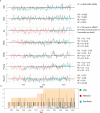Compound climate extremes driving recent sub-continental tree mortality in northern Australia have no precedent in recent centuries
- PMID: 34526586
- PMCID: PMC8443737
- DOI: 10.1038/s41598-021-97762-x
Compound climate extremes driving recent sub-continental tree mortality in northern Australia have no precedent in recent centuries
Abstract
Compound climate extremes (CCEs) can have significant and persistent environmental impacts on ecosystems. However, knowledge of the occurrence of CCEs beyond the past ~ 50 years, and hence their ecological impacts, is limited. Here, we place the widespread 2015-16 mangrove dieback and the more recent 2020 inland native forest dieback events in northern Australia into a longer historical context using locally relevant palaeoclimate records. Over recent centuries, multiple occurrences of analogous antecedent and coincident climate conditions associated with the mangrove dieback event were identified in this compilation. However, rising sea level-a key antecedent condition-over the three decades prior to the mangrove dieback is unprecedented in the past 220 years. Similarly, dieback in inland forests and savannas was associated with a multi-decadal wetting trend followed by the longest and most intense drought conditions of the past 250 years, coupled with rising temperatures. While many ecological communities may have experienced CCEs in past centuries, the addition of new environmental stressors associated with varying aspects of global change may exceed their thresholds of resilience. Palaeoclimate compilations provide the much-needed longer term context to better assess frequency and changes in some types of CCEs and their environmental impacts.
© 2021. The Author(s).
Conflict of interest statement
The authors declare no competing interests.
Figures




References
-
- IPCC Managing the risks of extreme events and disasters to advance climate change adaptation. In A Special Report of Working Groups I and II of the Intergovernmental Panel on Climate Change (eds Field, C. B. et al.) 582 (Cambridge University Press, 2012).
-
- Zscheischler J, et al. Future climate risk from compound events. Nat. Clim. Change. 2018;8:469–477. doi: 10.1038/s41558-018-0156-3. - DOI
-
- Zscheischler J, et al. A typology of compound weather and climate events. Nat. Rev. Earth Environ. 2020;1(7):1–15. doi: 10.1038/s43017-020-0060-z. - DOI
-
- Wahl T, Jain S, Bender J, Meyers SD, Luther ME. Increasing risk of compound flooding from storm surge and rainfall for major US cities. Nat. Clim. Change. 2015;5:1093–1097. doi: 10.1038/nclimate2736. - DOI
Publication types
LinkOut - more resources
Full Text Sources
Miscellaneous

